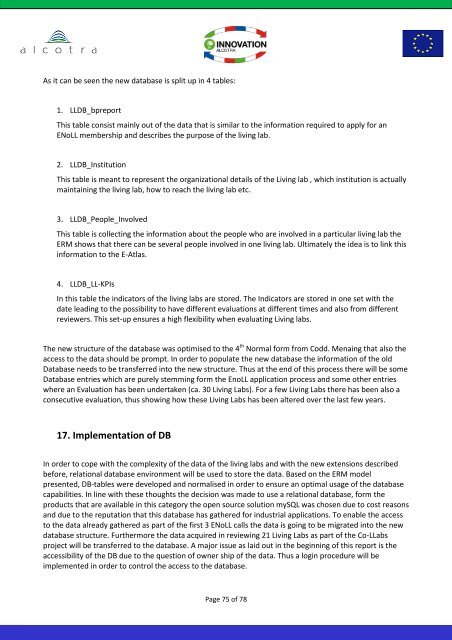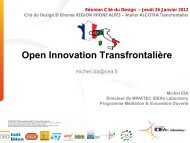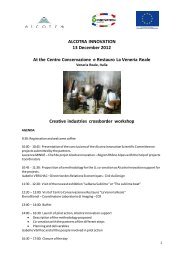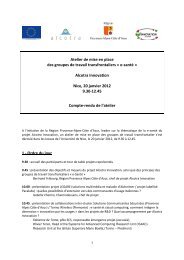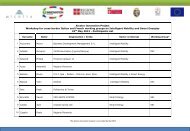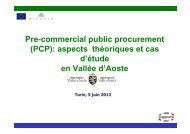Best practices Database for Living Labs - ALCOTRA - Innovation
Best practices Database for Living Labs - ALCOTRA - Innovation
Best practices Database for Living Labs - ALCOTRA - Innovation
Create successful ePaper yourself
Turn your PDF publications into a flip-book with our unique Google optimized e-Paper software.
As it can be seen the new database is split up in 4 tables:<br />
1. LLDB_bpreport<br />
This table consist mainly out of the data that is similar to the in<strong>for</strong>mation required to apply <strong>for</strong> an<br />
ENoLL membership and describes the purpose of the living lab.<br />
2. LLDB_Institution<br />
This table is meant to represent the organizational details of the <strong>Living</strong> lab , which institution is actually<br />
maintaining the living lab, how to reach the living lab etc.<br />
3. LLDB_People_Involved<br />
This table is collecting the in<strong>for</strong>mation about the people who are involved in a particular living lab the<br />
ERM shows that there can be several people involved in one living lab. Ultimately the idea is to link this<br />
in<strong>for</strong>mation to the E-Atlas.<br />
4. LLDB_LL-KPIs<br />
In this table the indicators of the living labs are stored. The Indicators are stored in one set with the<br />
date leading to the possibility to have different evaluations at different times and also from different<br />
reviewers. This set-up ensures a high flexibility when evaluating <strong>Living</strong> labs.<br />
The new structure of the database was optimised to the 4 th Normal <strong>for</strong>m from Codd. Menaing that also the<br />
access to the data should be prompt. In order to populate the new database the in<strong>for</strong>mation of the old<br />
<strong>Database</strong> needs to be transferred into the new structure. Thus at the end of this process there will be some<br />
<strong>Database</strong> entries which are purely stemming <strong>for</strong>m the EnoLL application process and some other entries<br />
where an Evaluation has been undertaken (ca. 30 <strong>Living</strong> <strong>Labs</strong>). For a few <strong>Living</strong> <strong>Labs</strong> there has been also a<br />
consecutive evaluation, thus showing how these <strong>Living</strong> <strong>Labs</strong> has been altered over the last few years.<br />
17. Implementation of DB<br />
In order to cope with the complexity of the data of the living labs and with the new extensions described<br />
be<strong>for</strong>e, relational database environment will be used to store the data. Based on the ERM model<br />
presented, DB-tables were developed and normalised in order to ensure an optimal usage of the database<br />
capabilities. In line with these thoughts the decision was made to use a relational database, <strong>for</strong>m the<br />
products that are available in this category the open source solution mySQL was chosen due to cost reasons<br />
and due to the reputation that this database has gathered <strong>for</strong> industrial applications. To enable the access<br />
to the data already gathered as part of the first 3 ENoLL calls the data is going to be migrated into the new<br />
database structure. Furthermore the data acquired in reviewing 21 <strong>Living</strong> <strong>Labs</strong> as part of the Co-L<strong>Labs</strong><br />
project will be transferred to the database. A major issue as laid out in the beginning of this report is the<br />
accessibility of the DB due to the question of owner ship of the data. Thus a login procedure will be<br />
implemented in order to control the access to the database.<br />
The project is co-funded by the ERDF<br />
Page 75 of 78


